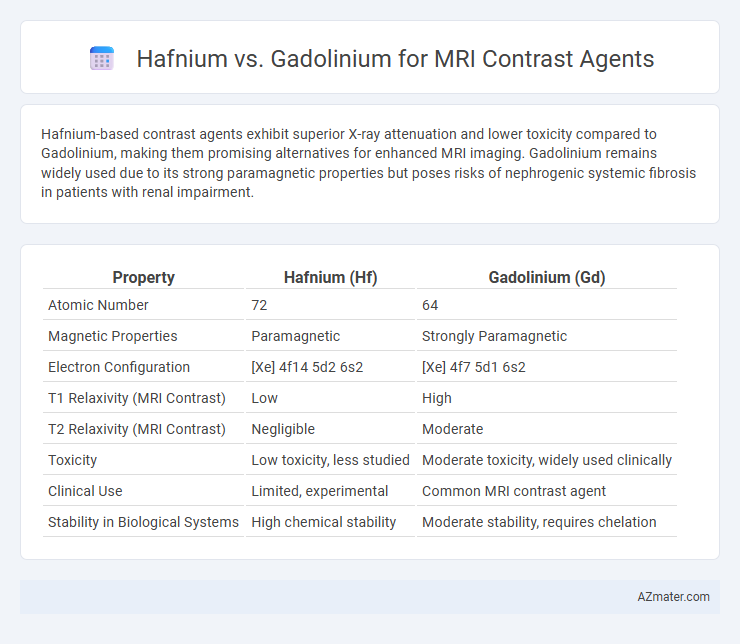Hafnium-based contrast agents exhibit superior X-ray attenuation and lower toxicity compared to Gadolinium, making them promising alternatives for enhanced MRI imaging. Gadolinium remains widely used due to its strong paramagnetic properties but poses risks of nephrogenic systemic fibrosis in patients with renal impairment.
Table of Comparison
| Property | Hafnium (Hf) | Gadolinium (Gd) |
|---|---|---|
| Atomic Number | 72 | 64 |
| Magnetic Properties | Paramagnetic | Strongly Paramagnetic |
| Electron Configuration | [Xe] 4f14 5d2 6s2 | [Xe] 4f7 5d1 6s2 |
| T1 Relaxivity (MRI Contrast) | Low | High |
| T2 Relaxivity (MRI Contrast) | Negligible | Moderate |
| Toxicity | Low toxicity, less studied | Moderate toxicity, widely used clinically |
| Clinical Use | Limited, experimental | Common MRI contrast agent |
| Stability in Biological Systems | High chemical stability | Moderate stability, requires chelation |
Introduction to MRI Contrast Agents
MRI contrast agents enhance image quality by altering the local magnetic environment, improving the differentiation of tissues in magnetic resonance imaging. Gadolinium-based agents dominate clinical use due to their strong paramagnetic properties, but concerns about toxicity and retention have prompted exploration of alternatives like hafnium-based nanoparticles. Hafnium exhibits promising high atomic number and biocompatibility, offering potential as an efficient contrast agent with reduced side effects compared to traditional gadolinium compounds.
Overview of Hafnium-Based Contrast Agents
Hafnium-based contrast agents for MRI leverage the element's high atomic number and strong X-ray attenuation properties, enhancing image clarity and tissue differentiation. Hafnium complexes exhibit favorable biocompatibility and stability, reducing toxicity risks compared to traditional gadolinium agents. Emerging research highlights hafnium's potential in targeted imaging applications, offering improved contrast with lower doses in both preclinical and clinical settings.
Gadolinium: The Traditional MRI Contrast Agent
Gadolinium, a rare-earth metal, has been the traditional MRI contrast agent due to its strong paramagnetic properties, which enhance the relaxation rates of water protons, thereby improving image contrast. Its chelated forms, such as Gd-DTPA and Gd-DOTA, are widely used for their stability and safety in clinical imaging. Despite concerns about gadolinium deposition in tissues, it remains the gold standard in MRI contrast agents for detailed visualization of vascular structures and pathological tissues.
Mechanisms of Action: Hafnium vs Gadolinium
Hafnium-based MRI contrast agents leverage high atomic number properties to enhance X-ray attenuation, contributing to improved image contrast primarily through electron density differences. Gadolinium agents function by altering local magnetic fields via unpaired f-electrons, accelerating relaxation times (T1 and T2) of surrounding water protons, which enhances signal intensity on MRI scans. The key mechanistic difference lies in gadolinium's paramagnetic effects directly influencing proton relaxation, whereas hafnium's contrast arises mainly from X-ray absorption characteristics, making gadolinium more specific for MRI contrast enhancement.
Safety and Toxicity Profiles Comparison
Hafnium-based MRI contrast agents demonstrate lower toxicity and reduced risk of nephrogenic systemic fibrosis compared to gadolinium agents, making them safer for patients with impaired renal function. Gadolinium, while widely used, has been associated with gadolinium deposition in brain tissues and potential long-term toxicity concerns. Advances in hafnium nanoparticle formulations offer promising biocompatibility and clearance profiles, enhancing patient safety during MRI procedures.
Imaging Efficacy and Signal Enhancement
Hafnium-based contrast agents exhibit superior X-ray attenuation properties and enhanced T1 and T2 relaxation effects, resulting in improved MRI signal enhancement and clearer imaging outcomes compared to gadolinium-based agents. Gadolinium contrast agents remain standard due to their effective paramagnetic properties, but concerns over nephrogenic systemic fibrosis and lower atomic number limit long-term safety and imaging sharpness. Studies highlight hafnium's potential for higher contrast-to-noise ratios and better spatial resolution, promoting it as a promising alternative for next-generation MRI diagnostics.
Pharmacokinetics and Biodistribution
Hafnium-based MRI contrast agents demonstrate prolonged circulation time and enhanced stability compared to gadolinium chelates, resulting in improved pharmacokinetics with slower renal clearance and reduced off-target deposition. Gadolinium contrast agents typically exhibit rapid renal elimination but pose risks of nephrogenic systemic fibrosis in patients with impaired renal function, influencing their biodistribution and safety profile. The larger atomic weight and unique electronic configuration of hafnium enable higher X-ray attenuation and improved imaging contrast, while its biodistribution favors accumulation in reticuloendothelial system organs, offering potential advantages in tumor imaging and reduced systemic toxicity.
Clinical Applications and Current Research
Hafnium-based compounds are emerging as highly effective MRI contrast agents due to their high atomic number, providing enhanced X-ray attenuation and superior image clarity compared to traditional gadolinium agents. Gadolinium remains widely used in clinical applications for its proven safety and effective T1 relaxation properties, though concerns about nephrogenic systemic fibrosis have driven research towards safer alternatives like hafnium nanoparticles. Current studies focus on optimizing hafnium's biocompatibility and targeting capabilities, aiming to improve diagnostic accuracy in cancer imaging and reduce adverse side effects associated with gadolinium-based agents.
Regulatory Status and Market Availability
Hafnium-based MRI contrast agents are currently in early research phases with limited regulatory approval, primarily undergoing preclinical and clinical trials, which restricts their market availability. Gadolinium-based agents dominate the MRI contrast market due to widespread FDA and EMA approvals, extensive clinical use, and established safety profiles despite concerns about gadolinium retention and toxicity. The established regulatory status and commercial presence of gadolinium contrasts make them the preferred choice, while hafnium agents continue to explore potential advantages such as reduced toxicity in ongoing studies.
Future Perspectives: Advancements in MRI Contrast Agents
Hafnium-based MRI contrast agents exhibit superior X-ray attenuation and biocompatibility, positioning them as promising alternatives to gadolinium agents, which face concerns related to nephrogenic systemic fibrosis and gadolinium deposition. Emerging research emphasizes hafnium's potential in multifunctional theranostics, integrating imaging with targeted therapy for enhanced diagnostic accuracy and treatment efficacy. Advances in nanoparticle engineering and ligand design are expected to optimize hafnium's contrast enhancement and safety profile, driving the next generation of MRI contrast media.

Infographic: Hafnium vs Gadolinium for MRI Contrast Agent
 azmater.com
azmater.com